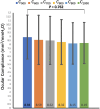Measurement device and derivation formula for static ocular compliance
- PMID: 40419702
- PMCID: PMC12106802
- DOI: 10.1038/s41598-025-03415-8
Measurement device and derivation formula for static ocular compliance
Abstract
To introduce a device for measuring static ocular compliance (SOC) and propose a best-fit formula. An observational experimental study involving patients with age-related cataracts was conducted between May 2024 and September 2024. Pearson's correlation analysis was used to screen for potential variables that were significantly associated with the SOC. Then, the SOC at six different height differences (recorded as "Δh") was compared, and the best-fit equations for SOC were screened by linear regression analysis. CΔh was defined as SOC at height difference of Δh mm. A total of 47 eyes of 47 patients (22 males [46.8%] and 25 females [53.2%]) were enrolled. The mean SOC was (0.846 ± 0.274) µL/cmH2O, with a 95% confidence interval of (0.813-0.879) µL/cmH2O, with ocular axial length (AL) of (23.74 ± 1.83) mm and central corneal thickness of (541.13 ± 35.34) µm. Furthermore, Pearson's correlation analysis revealed a significant correlation between SOC and AL (all P < 0.001). Using our device, the best-fit formula can be expressed as SOC = 0.948 x C600 + 0.067 x AL (R2 = 0.985; P = 0.000), with an optimal height difference of 600 mm. The designed in vivo measurement device can accurately measure SOC and derive a best-fit formula.
Keywords: Best-fit equation; Ocular biomechanics; Ocular rigidity; Static ocular compliance.
© 2025. The Author(s).
Conflict of interest statement
Declarations. Ethics approval and consent to participate: The study adhered to the tenets of the Declaration of Helsinki and its ethical standards. This study was approved by the Medical Ethics Committee of Xuzhou First People’s Hospital (approval number: xyy11[2024]112), and written informed consent was obtained from all the participants. Consent for publication: Not applicable. Competing interests: The authors declare no competing interests.
Figures



Similar articles
-
Interventions for myopia control in children: a living systematic review and network meta-analysis.Cochrane Database Syst Rev. 2023 Feb 16;2(2):CD014758. doi: 10.1002/14651858.CD014758.pub2. Cochrane Database Syst Rev. 2023. Update in: Cochrane Database Syst Rev. 2025 Feb 13;2:CD014758. doi: 10.1002/14651858.CD014758.pub3. PMID: 36809645 Free PMC article. Updated.
-
Sertindole for schizophrenia.Cochrane Database Syst Rev. 2005 Jul 20;2005(3):CD001715. doi: 10.1002/14651858.CD001715.pub2. Cochrane Database Syst Rev. 2005. PMID: 16034864 Free PMC article.
-
Surgical interventions for bilateral congenital cataract in children aged two years and under.Cochrane Database Syst Rev. 2022 Sep 15;9(9):CD003171. doi: 10.1002/14651858.CD003171.pub3. Cochrane Database Syst Rev. 2022. PMID: 36107778 Free PMC article.
-
Different-sized incisions for phacoemulsification in age-related cataract.Cochrane Database Syst Rev. 2017 Sep 20;9(9):CD010510. doi: 10.1002/14651858.CD010510.pub2. Cochrane Database Syst Rev. 2017. PMID: 28931202 Free PMC article.
-
Computer and mobile technology interventions for self-management in chronic obstructive pulmonary disease.Cochrane Database Syst Rev. 2017 May 23;5(5):CD011425. doi: 10.1002/14651858.CD011425.pub2. Cochrane Database Syst Rev. 2017. PMID: 28535331 Free PMC article.
References
-
- Shen, S. R., Fleming, G. P., Jain, S. G. & Roberts, C. J. A review of corneal biomechanics and scleral stiffness in topical prostaglandin analog therapy for Glaucoma. Curr. Eye Res.48 (2), 172–181 (2023). Epub 2022 Aug 5. - PubMed
-
- Faramarzi, A. et al. Systemic supplemental oxygen therapy during accelerated corneal crosslinking for progressive keratoconus: randomized clinical trial. J. Cataract Refract. Surg.47 (6), 773–779. 10.1097/j.jcrs.0000000000000513 (2021). - PubMed
-
- He, L. Y., Liang, L. & Zhu, M. N. Application value of corneal hysteresis in diagnosis and treatment of glaucoma. Zhonghua Yan Ke Za Zhi.53(2), 140–143. Chinese. (2017). 10.3760/cma.j.issn.0412-4081.2017.02.013 - PubMed
Publication types
MeSH terms
Grants and funding
LinkOut - more resources
Full Text Sources
Medical

